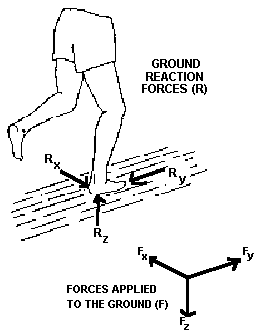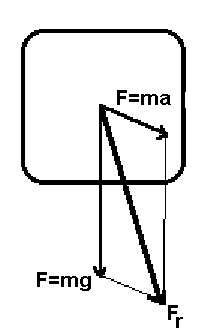

| The ground reaction force vector (GRFV) passes upward from the foot and produces movement at each lower extremity joint. We can visualize the GRFV by studying laboratory investigations of normal gait that employ force plates to measure the GRFV's three-dimensional orientation. |
|---|
The GRFV differs from a "gravity line," which is a vector that extends vertically from the center of gravity of a static body. Instead, the GRFV is a "reflection of the total mass-times-acceleration product of all body segments and therefore represents the total of all net muscle and gravitational forces acting at each instant of time over the stance period" (Winter, 1984, p.51).

|
F=mg designates the vector that represents the force of gravity acting on the objectF=ma designates the vector that represents the instantaneous inertial force acting on the object. In this diagram, inertial forces accelerate the body toward downward and to the right. Vector (Fr) is the resultant or sum of the gravitational and inertial forces. |
|---|
In contact with a stable surface like the ground, vector Fr represents a force that is opposed by a ground reaction force of equal magnitude. Because the ground reaction force is equal and opposite, its vector's line of application is the same as that of Fr, and it has the same effect on the body and its joints.
The GRFV combines both gravity's effect on the body and the effects of the body's movement and acceleration (change of velocity) in three planes of reference. This makes the GRFV especially suitable for the study of gait, during which the body's various masses undergo complex accelerations.
Sophisticated gait analysis equipment can generate a visible force vector on an oscilloscope screen and superimpose it simultaneously on a photograph of a gait subject. Visualizing ground reaction forces helps us understand their effects on the body during walking, and permits us to predict muscle activity using a simple model:
We can predict muscle activity quite accurately if we take the view that the ground reaction force (GRF) and the muscles (mm) produce equal and opposite moments (M) around each joint.
A WORD OF CAUTION: The ground reaction force is not the only force acting on joints during gait. The weight and inertia of a moving segment has an effect on the segments distal and proximal to it. Moving the upper leg influences movement in the lower leg. These joint reaction forces can be important. However, joint reaction forces are relatively small in the lower extremity, at least during stance phase. Therefore, clinicians can use the GRFV's position by itself to understand the forces that human muscles must control during gait's stance phase.
References
Winter, D. (1984) Kinematic and kinetic patterns in human gait. Human Movement Science, 3, 51-76.)